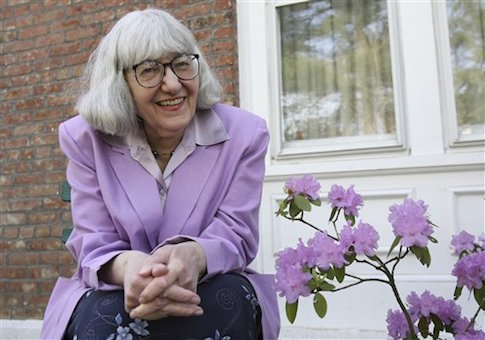Novelist and critic Cynthia Ozick is, in some respects, a typical contemporary literary essayist. She approaches her topics obliquely, moving from one phenomenon or observation to the next, drawing them together in the service of an argument in the middle of the piece or—more rarely—at the end. A discussion of Saul Bellow’s "lastingness," for example, is approached through his letters. An essay on criticism today (or the lack of it) begins with a blow-by-blow of a twenty-year-old spat between Jonathan Franzen and Ben Marcus. A piece on "W. H. Auden at the 92nd Street Y" first mentions Auden about a quarter of the way in.
A little fewer than half of the titles are fashionably suggestive. Instead of "On Friendship" (Joseph Addison) or "Of the Standard of Taste" (David Hume), we have "Nobility Eclipsed" (on the Hebrew language and translation) or "The Rhapsodist" (on Harold Bloom). There’s also a predilection for elaborate effusiveness.
What sets Ozick apart is her precision. Adjectives and nouns strung together in ornate expressions of supposedly refined feeling are depressingly easy to find in an age, such as ours, that values artifice over truth. Not in Ozick’s latest collection, Critics, Monsters, Fanatics, and Other Literary Essays. Extravagance and exactitude don’t always tango, but missteps are relatively rare. Contemporary poetry, she writes, is characterized by a "slough of trivia and loss of encompassment, the herding of random images of minuscule perspective leading to a pipsqueak epiphany," while in Auden’s "September 1, 1939," she writes, "there are no symbols, no arcane ‘objective correlative.’ Invasion and war, violence and dread, horizon and olfactory nerve, place and time—the kernel of the hour, its history and politics—are intimately knotted in these plainspoken lines."
Even sentences that, at first, seem profligate show themselves to be necessarily so on a second reading. At the beginning of "Transcending the Kafkaesque," for example, Ozick writes: "Franz Kafka…has himself metamorphosed into an empire of boundless discourse, an empire stretched out across a firmament of interpretation: myth, parable, allegory, clairvoyance, divination; theory upon thesis upon theophany; every conceivable incarnation of the sexual, the political, the psychological, the metaphysical. Another study of the life? Another particle in the deep void of a proliferating cosmos." Through a sort of mimicry, Ozick’s proliferation of abstract nouns captures how Kafka’s name has become a catchphrase—divorced from the particulars of his life and work—for ill-defined ideas.
She is also the queen of the thunderbolt. "A critic," Ozick writes, "is, at bottom, a judge, and judgment ought not to be tentative, or it is flat and useless," and tentative she is not. She scolds "academic theorists" who have "marinated literature in dogma" and who write "in a kind of multisyllabic pidgin." She dismisses the contemporary avant-garde by remarking that "nothing is more exhaustedly old hat than the so-called experimental." "Whoever utters ‘Kafkaesque’," she writes, "has neither fathomed nor intuited nor felt the impress of Kafka’s devisings."
But she can be wrong. Surely Eliot’s fame has not "shrunk to a period datum," nor is she right—as much as I love Bellow—that the novelist, compared to his contemporaries, "alone courts lastingness, he alone escapes eclipse."
I found her opening essay on the need for criticism today, where she draws a hard line between criticism and review writing, particularly baffling. Not only does she overstate the function of criticism—what does it mean to "stimulate a living literary consciousness"?—but she also arbitrarily determines that the length and limits of a review (the focus on a single book) make them categorically different from the literary essay. "Critics," Ozick writes, "belong to a wholly distinct phylum."
But why should this be the case? If a reviewer is not free, according to Ozick, to "summon…multiple histories, multiple libraries, multiple metaphysics and intuitions," how about one or two? Does a word count limit of 1,500 mean that no general arguments can be made about the meaning of life or the place of a work or style in the history of writing? If so, why did Ozick include her 1,600-word review of Harold Bloom’s The Daemon Knows in this collection of "literary essays"? Surely, she protests too much, and she knows it.
A lot of junk is called art today, and Ozick is not afraid to take out the trash, but she’s mostly focused on what’s worth keeping. In addition to essays on Bellow and Auden, we have pieces on Lionel Trilling, Bernard Malamud, Martin Amis, and others of that sort. Her preoccupation in most of these is what makes her a great writer and a great critic. The answer—to do the collection injustice—is insight, freedom, courage, genius.
One of the few essays not on an individual writer is "Writers, Visible and Invisible." While academics and magazine editors might render some great writers and texts temporarily invisible by confusing "ideologically narrow prejudices" with taste, the true writer will always become visible eventually, though only in the work. This is why all true writers, according to Ozick, are ghosts. They live but are never fully present in flesh and blood. "The fraudulent writer," by contrast, "is the visible one, the crowd-seeker, the crowd-speaker, the one who will stand and talk to you, or will discuss mutual writing habits with you, or will gossip with you about other novelists and their enviable good luck."
She’s wrong about the gossip, but probably right about everything else. Many people can’t tell the difference between real and so-called poets, who have merely mastered the game of book publication and university appointment, which in turn bankrolls the sunglasses and tweeds. A sad state, no doubt, but not all that new, and it’s the critic’s job to make the difference apparent. Ozick’s judgment isn’t perfect—whose is?—but she’s playing the right game in Critics, Monsters, Fanatics, which is always for keeps.
